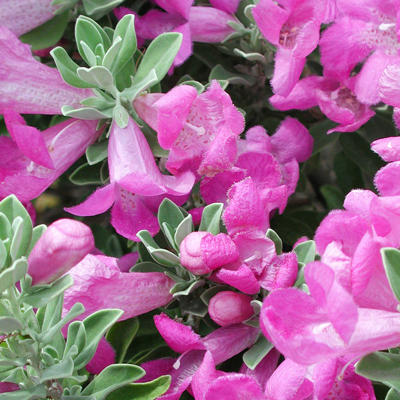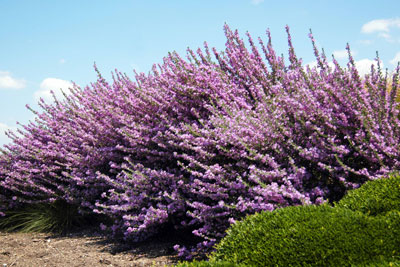Plant of the Week: Texas Sage (Ceniza)

Photo: When it’s in full bloom, Texas sage is a handsome sight.
Getting to the roots of Texas sage…
As I worked alongside my friend the late Benny Simpson at the Texas A&M Center on Coit Road in Dallas in the mid-1970s, he would describe hillsides near George West, Texas, as being literally covered in Texas sage plants in full bloom after rains. Benny was an outstanding research horticulturist, and he would hustle down there the day after rains to try to find unusual colors of flowers.
These wonderful shrubs bloom two or three days after rainfall. Indeed, that’s where their other common name originates: “barometer bush.” Some summers that may mean three or four rounds of blooms. Other years, it may be far fewer. But it’s always amazing to watch it happen. And no, you can’t trick them into flowering by soaking them heavily.
Cenizas are native to a hot, dry part of our state. You’d think they’d be grateful to be planted in areas where rainfall is more abundant, but that’s not always the case. They’re not native to North Central Texas, for example, for a couple of reasons, even though you’ll see them used frequently in commercial and residential plantings there. Extremely cold winters take a bad toll on them, and prolonged periods of heavy rain such as we had in 2015 cause root loss and plant death as well. But in the right environment with winter protection and elevated planting beds, their range of adaptation can be broadened very nicely.

Photo: Texas sage planting in the Metroplex is atop a well-draining hill.
Give cenizas full sun. You can watch their performance decline as trees grow up and over them, so plan for the future.
Trim Texas sage plants only as needed to maintain their attractive growth form. It’s usually best to do that trimming with hand shears or loppers. Avoid formal shearing if you possibly can.
Visit a nursery near you this month, and you’ll probably find several cultivars of Texas sage. ‘Green Cloud’ has green leaves and darker flowers than the species Leucophyllum frutescens. You’ll also find the native species, compact and white-flowering forms and several others.
Keep your eyes open for Texas sage plants to bloom as late summer and fall rains (hopefully) return. Their first flowers this year were way back in late spring, and the final burst could come into late September and even early October. Nice plants!
